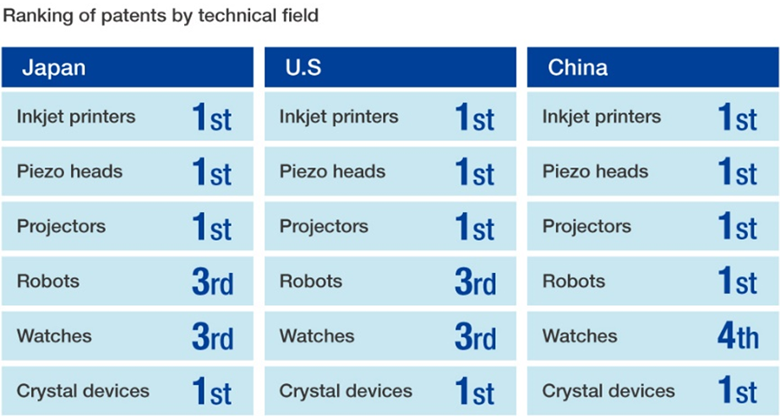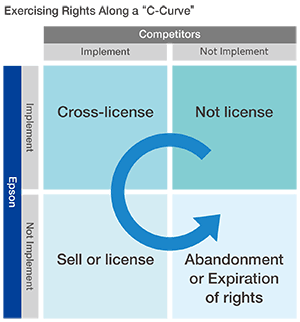Acquisition and Utilization Strategies
Epson's Acquisition and Utilization Strategies for Intellectual Property Rights
As a practice of proactive intellectual property activity, Epson is committed to building an intellectual property portfolio by forward-thinking acquisitions of various intellectual property rights (patents, design rights, trademarks, etc.) in a strategic, efficient, and effective manner.
Building an Intellectual Property Portfolio using an IP Mix
Epson is developing an IP mix strategy to protect its proprietary core technologies and services through the acquisition of patents, design rights, and trademarks. Under the IP mix strategy, Epson is building a multifaceted intellectual property portfolio that includes patent rights for technologies related to brand identity, design rights for product designs, and trademark rights for names.

World-Class Portfolio of Patents
The core of Epson's intellectual property acquisition activities is its patent application prosecution activities, in which Epson files for and obtains patents for inventions that are generated as a result of its technological development. Epson has built an industry-leading intellectual property portfolio and protects its proprietary core technologies by filing world-class patent applications, both in quality and quantity, in technology fields such as inkjet printers, projectors, robotics, and crystal devices.

*Number of published patents in 2021 (Epson survey, utility model applications in China are not included)
Utilization Strategies for Intellectual Property Rights including “BP”
Epson defines outstanding patents that elevate our competitive advantage and contribute to higher profit as Brilliant iP or Brilliant Patents (BP), and Epson is pursuing the acquisition of BP in a timely manner in response to the management and business environment.
The ideal strategy for utilizing intellectual property portfolio including BP is depicted in a four-quadrant chart that shows how Epson implements its patents on one axis and how our competitors implement their patents on the other axis. The location of rights on the chart moves from the top-right quadrant to the quadrant on the top left, then the bottom left and, finally, the bottom right. Epson calls this a "C-Curve."
Apart from this, Epson also utilizes its intellectual property portfolio for brand protection activities and brand promotion activities.

-
1.Non-licensed quadrant: In-house implementation, no implementation by
other companies
Epson obtains and protect rights on core technologies that are a source of competitiveness not granting licenses to others.
-
2.Cross-licensing quadrant: In-house implementation, implementation by
other companies
Epson tries to ensure business flexibility by entering into cross-licensing agreements with competitors who want to use our rights.
-
3.Selling and licensing quadrant: No in-house implementation,
implementation by other companies
Epson obtains a return on investment (revenue) by either selling or licensing to others rights that have contributed to the growth of business through cross-licensing agreements.
-
4.Abandonment and expiration quadrant: No in-house implementation, no
implementation by other companies
Maintaining rights is costly, so Epson actively abandons rights that are unlikely to be productive.


